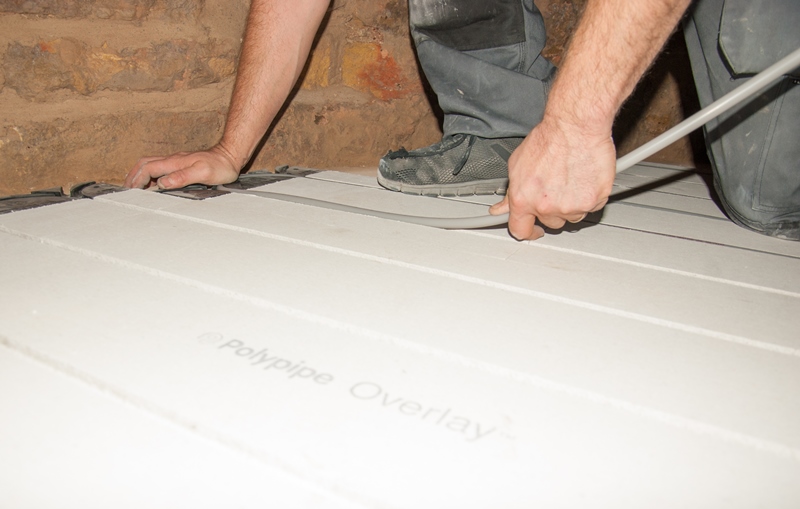
Polypipe Building Products takes a look at what installers need to know about Part L of the Building Regulations.
In June 2022, updates to the building regulations Part L, which cover the energy performance of new and existing buildings England and Wales, came into force.
Since then, the industry has been in a transitionary period. This means that work on homes with planning approval under the older regulations has been able to proceed as long as it was started within 12 months of the regulations coming into force. However, the transitionary period is now drawing to a close. From June 2023, all projects – retrofit and new build – will need to adhere to the new regulations. So, now is the time for installers to familiarise themselves with the regulations and the impact that compliance will have on their work.
As we are all aware, the way that we heat our homes is one of the biggest contributors to carbon emissions in the UK. So, the primary aim of the new regulations is to achieve a 31% reduction of carbon emissions in new and existing homes as a precursor to the Future Home Standard due to come into force in 2025.
The Future Homes Standard has been designed to ensure that, on average, new home produce at least 75% less CO2 emissions than a home that has been built to current energy efficiency requirements. This will mean that all future homes are net-zero ready and will not need retrofitting.
Of course, a reduction on 75% will be no small feat, so understanding and complying with Part L now will provide the industry with a stepping stone towards meeting the government’s ambitious targets.
Lower flow temperature
One of the biggest changes to the regulations is that the maximum flow temperature for newly installed heating systems is now 55°C, which is much lower than the previous standard of 80°C. This lower temperature means that the heat emitters in a home will need careful consideration and some radiators will need to significantly increase in size, presenting space and aesthetic issues.
For example, to provide 900 watts of heat output with a flow and return of 45°C/35°C, a double panel radiator would need to be 1800mm L x 600mm H compared to 1000mm L x 600mm H when using 75°C/65°C. This means that it is worth looking at alternative emitters that have been designed to run at the lower temperatures laid out in the new regulations.
Alternatives could be heating emitters with a larger surface area, including underfloor heating. As underfloor heating covers a greater surface area, it can run at lower temperatures – between 33-55°C rather than 75°C. This means that the demand underfloor heating places on energy sources is significantly less, making them ideal for use with low temperature boilers and renewables, such as heat pumps. In fact, due to its ability to run at lower temperatures, UFH can perfectly accommodate the optimal coefficient of performance (COP) for heat pumps, which is attained when they run at 35°C.
If it’s not possible to achieve a flow temperature of 55°C – which may be the case in properties where there is insufficient space for larger radiators, or where the existing distribution system is provided with higher temperature heat from a low carbon district heat network – then the system will need to be designed to achieve the lowest flow temperature possible, whilst still meeting the heating needs of the property.
A smarter choice
Heating controls are another key element of the building regulations. New systems in homes with a floor area of 150m² or greater will now need a minimum of two independently controlled zones with each room, or zone, requiring its own smart or thermostatic controls. This is because splitting the system into zones means that the levels of heat being emitted in certain areas can be controlled and that residents can choose to heat only the parts of the property that are in use, and turn heating off in any rooms where heat is not required. As a results, less energy will be wasted.
For traditional convectional heating, this can be satisfied through a thermostat or thermostatic radiator valves on all heat emitters in the rooms that do not have a thermostat. For all hot water stores, a timer for heating and timer for hot water is required so that they can be controlled independently of the space heating circuit.
Underfloor heating can be installed in the same way it always has been – no additions required. This is because it is naturally designed and installed into zones. Therefore, underfloor heating manifolds are able to control multiple zones at once, allowing each area – or room – to be warmed to a different temperature depending on the user’s requirements.
In addition, the pump now needs to automatically turn off when heat is not required. So, the system controls should be wired to ensure that when there is no demand for heating or hot water, the heating appliance and pump are switched off.
Insulating the nation
In line with the new regulations, any new pipework will now also have to be insulated. This includes primary circulating pipes for heating circuits, including those that pass into voids or ducts, pipework for domestic hot water, all cylinder pipework and all secondary circulation pipework. All pipes connecting to a hot water storage unit will also need to be insulated for at least 1m from where they connect to the unit.
In existing systems where the boiler or cylinder is replaced any new exposed pipework must now be insulated. It’s also worth noting that pipes need to be heat pump ready and have at least a diameter of 15mm. Installers will need to comply with this when working on new builds in particular as photographic proof will be required.
As you can see from above, Part L is not just for new builds. Many aspects of the new regulations will have a large impact on how engineers design and install new systems into existing properties. So, it is crucial for any professional operating in the industry to get a firm hand of the updated regulations ahead of the looming deadline in June 2023.













